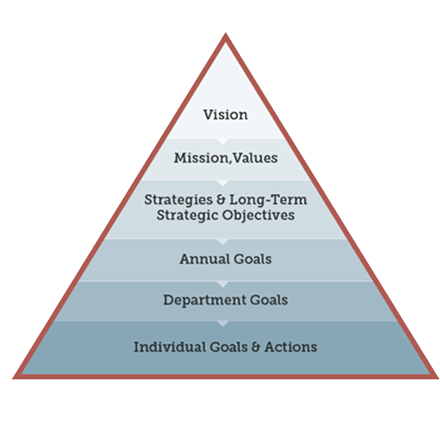How do you know if you have a complete strategic plan? A complete strategic plan has several components, but the various parts fall into three categories. Following our step-by-step guide, you’ll learn how to write a strategic plan quickly.
Not to oversimplify how to write a strategic plan, but by placing all the parts of a strategic plan into three areas or categories of focus, you can see how the pieces fit together.
The three pieces of the puzzle are:
- Where are we now?
- Where are we going?
- How will we get there?
Get the Free Guide to Build Your Strategic Objectives (with Examples!)
Each part has certain elements to show you how and where things fit. Our 4-Phase Guide to Strategic Planning lays out each step of the planning process. You can also watch our video, The Complete Strategic Planning Checklist” for a brief overview.
Get the Free Guide for Setting OKRs that Work (with 100 examples!)
Video Transcript – The Complete Strategic Plan
Hi everyone, its Erica Olsen from OnStrategy. Welcome to today’s whiteboard video on “Do You Have a Complete Strategic Plan?”
As you would expect from us, we’re going to make that as easy as possible and give you a checklist — and a checklist not only for a complete plan — but for an awesome plan. So, let’s jump in.
First things first, you need a couple of things that set your strategic direction: your mission statement, which tells us why you exist, your reason for being, and your vision statement of where you’re going. You’ve heard me say it a million times, strategic plans are all about going to a place that you are not today. And your vision statement answers that. We often lump values in this area: mission, vision, and values, because it sounds good.
But I would say that a strategic plan does not have to have values if you don’t have them already articulated. And the only reason for that is because I would highly recommend that you take a values process and run that separately from a strategic planning process, because there’s a lot of work there. And it deserves its own time and attention. And if you have your values, they should go in here if you don’t put a placeholder.
So then we move to strategy. In order to articulate your strategy, you’ve got to understand where you are today. And we use a trusty tool that is a SWOT–Strengths, Weaknesses, Opportunities, and Threats. So once you have a clear understanding of where you are today, and where the opportunities are for growth, you can build out the strategy areas of your plan, which look like this: your strategic goals.
Those are the four, or five, or six big areas of focus that make up the framework of your plan that are super important. Everything rises and falls here–your vision connects to your goals and your goals connect your objectives.
Also, in your strategy is your org-wide strategies or your organizational-wide strategies. Those are the differentiation statements, or how you’re different. Strategy is about being unique. And that’s what that statement does for you.
And then of course, clarifying where are we going to play? How are we going to win? That’s your growth strategy. Strategic plans have got to have a growth section. That’s your competitive advantages and your customer segments. So, once you have all that articulated, we can move to your annual plan, which looks like organization-wide objectives.
Those are your SMART objectives. They should be measurable, time bound, accountable, all that good stuff. Each of your strategic initiatives should have at least one or two quarterly action items to ensure you can really move them in to execution. And of course, no good plan is done unless you’re clear about how you’re going to measure your success–key performance indicators or KPIs. So with that, there’s your checklist for a complete and awesome strategic plan.
Hit the like button if you like our content, and please subscribe to our channel. We’re dropping videos every Friday. Happy strategizing.
Plan Writing Step 1: Establish Your Strategic Foundation
The first step in any business strategy or organizational strategy is to start by establishing or confirming your strategic foundation – in simple terms, we mean clearly articulating why your organization exists and how you expect your team to behave (Mission and Core values). This phase of the strategic planning process creates the foundation of your strategic plan as it tells you and the rest of your organization what your starting point is and why you generally exist (your core purpose or mission).
After setting up the foundation, you can determine where you’re going or hope to go in the future and exactly how you will get there by steering your organization in the right direction.
Where are we now?
As you think about where your organization is now, you want to look at the foundational elements of your organization’s purpose and culture (mission + values) and assess your organization’s current state (SWOT and competitive advantages).
This portion of strategic planning is designed to outline the core foundation of your organization, like why you exist and how you behave, while looking at the internal and external factors that will influence your planning elements. Below is a quick overview of those elements, which include a breakdown of your mission statement, core values, and SWOT analysis.
Who are we, and how do we behave?
Mission statement
The mission describes your organization’s purpose – the purpose for which you were founded and why you exist.
Some mission statements include the business of the organization. Others explain what products or services they produce or the customers they serve. Does your mission statement say what you do? Why does your organization exist?
Core Values:
This clarifies what you believe and how you expect your team to behave.
Three questions to ask to clarify your core values include:
- What are the core values and beliefs of your organization?
- What values and beliefs guide your daily interactions?
- What are you and your people committed to?
While a values statement is foundational to your overall strategy, the values process can be run separately from the strategic planning process as it needs its own time and attention. Your value statements are the barometer to determine whether you are conducting your business in a way that stays true to your organization’s purpose.
Video Transcript – Overview of the Strategic Planning Process
Hi, my name is Erica Olsen. Today’s whiteboard video is an overview of the strategic planning process. Instead of going through a bullet pointed list, we’ll do it in the form of an illustration.
To orient ourselves, I want to outline the four phases of the process over here: assess, design, build, and manage. The phases of planning include assessing, designing, and building, and we spend a couple of months per year doing that.
We spend the rest of the year managing the performance and the execution of our plan. Oftentimes, we get into execution, and we’re not exactly realizing the results that we want. In which case, we go back into some parts of the planning process, and sort of rinse and repeat. Today’s video is going through the whole process, but sometimes you just make big pieces of it. So, let’s jump in.
Great strategic plans start with understanding where we are today–assessing the current state– point A. We do that by gathering an external perspective, opportunities and threats, and an internal perspective, strengths, and weaknesses. And we summarize all that information and do a SWOT analysis. And as a little Asterix, we have detailed whiteboard videos on each point today. So, if you need to dig deeper, check those out.
So, once we’re clear about where we are today, we can move into the second part of our process, which is designing the strategy, starting with our mission statement. Our mission statement is a square here because great mission statements tell us what’s in and what’s out. Why do we exist as an organization, what’s our core purpose, and then by default, what’s not. With clarity on our mission, we can move to casting our vision or our future state.
Strategic plans are all about moving organizations from where we are today to where we want to be in the future. And that’s what our vision statement does for us. It tells us where we want to go.
The rest of our plan builds a roadmap from today to tomorrow. Starting with a couple of things that help us answer, “How will we succeed?” our competitive advantages, and our long-term, organization-wide strategies. These come in different names, but let’s just use the analogy and the visual to keep us grounded.
These help as guides. They act as an umbrella over our entire plan to make sure that we’re building a plan that we can succeed and be successful and be competitive with. So, with that guideline in place, we can move to building our framework–our long-term strategic objectives. Again, there are different names for this, but let’s just use that for today. I like to see them in four categories because we want a holistic framework. We want to make sure that our plan covers our financial perspective, our customer perspective, our operational and internal perspective, and our people perspective.
Less than six strategic objectives is a pretty good idea when you’re looking at your framework because we’re going to cascade the rest of the plan from these. From there, we’re ready to move into the next phase, which is building our plan.
That looks like starting with our goals, or our corporate goals. And we’re using the word ‘goals’ to articulate quantifiable, outcome-based statements. Where do you want to be in year one, and year two, and year three? And most of the time, we use key performance indicators to help guide us along the way.
So, we like our corporate goals. And again, we’re going to cascade from our strategic objectives. We like our corporate goals to be SMART. SMART is a great acronym to make sure that you have good, quantifiable, outcome-based goals: Specific, Measurable, Attainable, Realistic, and Time-bound.
Once we have our corporate goals in place, a couple per each long-term, strategic objective, we’re ready to move into annual operating plans. And that looks like building goals and cascading into each level of the organization. So that looks like corporate goals being cascaded into department goals, and department goals being cascaded into individual, contributor goals.
Once we’ve cascaded it down that far, we have a plan, and we’re done with the third phase. So now we have a plan. Now what? We want to move into managing execution because nobody wants to build a plan that sits on a shelf. So, there are three things you need to have in place to effectively execute.
Number one: people. You need to make sure that every person in your organization has an individual action plan that expresses ownership and accountability for what they need to get done by when. And with that, that matters because all the rest of this is just on paper if we’re not clear about that very specific piece.
The second thing is we need to make sure that we have a system in place to track and manage performance. A software system, spreadsheets, whatever it looks like, you’re going to gather a lot of data on a monthly, or quarterly and annual basis, you need a place to put that, and everybody needs to be working on the same system.
The third thing is process. You need to schedule at least monthly, or quarterly reviews of your performance because without that review, all the rest of this is just again, good ideas on paper.
So, with that, that’s an overview of the strategic planning process. Subscribe to our channel. Happy strategizing.
Plan Writing Step 2: Conduct a Current State Assessment
Where are we now?
As you think about where your organization is now, you want to look at the foundational elements of your organization’s purpose and culture (mission + values) and assess your organization’s current state (SWOT and competitive advantages).
This portion of strategic planning is designed to outline the core foundation of your organization, like why you exist and how you behave, while looking at the internal and external factors that will influence your planning elements. Below is a quick overview of those elements, which include a breakdown of your mission statement, core values, SWOT analysis, and business objectives..
Internal and External Analysis
When assessing your current position, you must conduct a thorough internal and external analysis of your organization. This includes assessing two major things:
- How well you are meeting your customer and market needs.
- How well do your internal processes and employees rate in terms of efficiency and satisfaction?
It may be tempting to skip this step or feel like you know where your organization stands and can make do with a less formal process, but this is not the case. Conducting a formal internal/external analysis via a SWOT, PESTLE, market analysis, or even employee surveys will help you lay the groundwork for your strategic plan.
Successful attributes of an internal and external analysis:
- Your organization’s strengths
- Weaknesses for your organization to improve upon
- A clearly defined competitive advantage
- Market opportunities to pursue
- An understanding of your competitor’s competitive advantages
- Strategic themes that serve as the framework of your plan
SWOT
SWOT is an acronym that stands for strengths, weaknesses, opportunities, and threats. These elements are crucial in assessing your strategic position within your organization. You want to build on your organization’s strengths, shore up the weaknesses, capitalize on the opportunities, and recognize the threats.
The SWOT can also be used as a forward-looking tool to determine where you want to go, as it allows you to see where your opportunities or threats may be in the future. These can help you pinpoint what some of your growth opportunities are.
Plan Writing Step 3: Create Your Vision of the Future
Where are we going?
The elements of the question “Where are we going?” help you answer other questions such as “What will my organization look like in the future?”, “Where are we headed?”, and “What is my vision of the future I want to create for my company?” Because the future is hard to predict, you can have fun imagining what it may look like. The following elements help you define the future for your business:
Vision Statement
Your organization’s vision statement is the articulation of what your organization’s future makeup will be and where the organization is headed. What will your organization look like in 5 to 10 years from now? What are your company’s goals that you seek to accomplish? What is your desired future state?
It’s important that your organization’s vision always remains relevant and clear. We recommend a vision that is big, bold, and audacious—like “All children achieve their full potential” from Big Brothers Big Sisters of America.
A vision statement like this would probably be true and relevant to the organization for its entirety. A vision statement may only need to change if the organization is making big moves or pivoting to address major shifts in the market or industry.
Sustainable Competitive Advantage
A sustainable competitive advantage explains what you are best at compared to your competitors. Each company strives to create an advantage that continues to be competitive over time. What can you be best at? What is your uniqueness? What can your organization potentially do better than any other organization?
Growth Strategy
Strategy is ultimately about being unique. It is about playing to the strengths that make your organization different from the others in your market. It establishes a way to match your organization’s strengths with market opportunities so that your organization comes to mind when your customer has a need.
This section explains how you travel to your final destination. Does your strategy match your strengths in a way that provides value to your customers? Does it build an organizational reputation and recognizable industry position?
Your growth strategy should clarify:
- Where are we going to play?
- How are we going to win?
Growth strategies are where your competitive advantages and your customer segments come into play. Once you have all that articulated, you can move to your annual plan, which looks taking your organization-wide objectives and building a strategic framework.

Plan Writing Step 4: Build Your Plan
How will we achieve our vision with action?
Strategic objectives are the steps that bridge the gap between where you are and where you want to be. They also connect your big, bold vision to the annual goals you need to achieve it and establish the boundaries for your organization’s focus.
Strategic Objectives
Knowing how you’ll reach your vision is the meat of your strategic plan, and it’s also the most time consuming. The reason it takes so much time to develop your strategic priorities is because there are a number of routes from your current position to your vision. Picking the right one determines how quickly or slowly you’ll get to your final destination.
Strategic objectives are long-term, continuous strategic areas that help you connect your growth strategy and annual actions to your long-term vision of success. Strategic planning with holistic objectives encompasses four areas:
- Financial
- Customer
- Operational
- People
Ask yourself what the key activities within these four areas are that you need to perform in order to achieve your vision.
It’s also important to separate your strategic objectives from your day-to-day operational objectives. They almost act like ‘mini vision statements’ as they support the overall vision of success by focusing on manageable focus areas.
Ultimately, your strategic objectives are not a mishmash of department goals. Instead, they embody the company-wide direction. They are what drive the direction and growth.
It is recommended to have at least four to six strategic objectives. They are your areas of focus that create the framework for your plan, and this should stem from your vision. Your vision connects your goals, and your goals connect your objectives. Your objectives should be SMART–specific, measurable, achievable, relevant, and time-bound.
Short-term Goals/Priorities/Initiatives
Short-term strategic goals convert your strategic objectives into specific performance targets. You can use goals, priorities, or initiatives interchangeably. Here, the term ‘goals’ defines short-term action. Effective goals clearly state:
- What you want to accomplish.
- When you want to accomplish it.
- How you’re going to accomplish it.
- Who is going to be responsible.
All goals or strategic initiatives should be specific and measurable:
- What are the 1- to 3-year goals you’re trying to achieve to reach your vision?
- What are your specific, measurable, and realistic targets of accomplishment?
Within your strategic plan, you should set milestones to measure achievement and motivate your team. Setting milestones also sets clear expectations of who is in charge of specific tasks and results.
Additionally, milestones help teams determine whether resource allocations serve to assess risks or upcoming obstacles. Strategic plans are iterative rather than sequential, so setting milestones can allow your plan to be more adaptive to address changes in the market rather than changing the overall strategic goals.
Action Items
Action items are plans that set specific actions that lead to implementing your goals. They include start and end dates and appoint a person responsible. Are your action items comprehensive enough to achieve your goals?
KPIs and Scorecards
A scorecard measures and manages your strategic plan. Each goal should have some form of measurement, whether that is through key performance indicators (KPIs) or some other method of measurement. What are the key metrics and KPIs you need to track to monitor whether you’re achieving your mission? Pick 5 to 10 goal-related measures you can use to track the progress of your plan and plug them into your scorecard.
Execution
In executing the plan, identify issues that surround the management and monitoring of the plan and how the plan is communicated and supported throughout your entire organization. How committed are you to implementing the plan to move your organization forward? Will you commit money, resources, and time to support the plan?
As you’ve been going through the planning and assessment phase of your strategic plan, you’ve hopefully thought of the resources needed to achieve this, including team members who will play a crucial role in executing the plan. Clear communication and support from your entire organization are essential for the successful execution of your strategic plan.
Before you begin executing your plan, it is essential to ensure that you have your resource allocation fully ironed out. This will prevent the possibility of ‘scope creep’ and keep you and your team aligned on your needs.
Another consideration for successful strategic plan implementation is ensuring stakeholder and employee buy-in. Stakeholder buy-in is crucial for any strategic plan.
- Identify your key stakeholders.
- Make sure you and your team understand everyone’s role in the process.
- Establish communication channels.
- Offer active listening and transparency.
- Celebrate the milestones.
However, buy-in really begins before the execution of your plan. If you’re waiting until it’s time for them to act on the plan before you consider whether they are bought in, then it’s a little late in the game. If you aren’t giving your team a voice in the planning and analysis stage and getting their input on the issues your organization faces, it will be harder to get them to buy-in to the implementation stage.
Revisiting and Refining your Strategic Plan
As stated before, the strategic planning process is iterative. It won’t always be a linear process with linear progress and achievements. This is why regularly revisiting your plan and making adjustments as needed is essential. Monitoring the pulse of your strategic plan is something that can be done by implementing a regular review cycle quarterly and revisiting your annual goals at the beginning of each fiscal year to determine what is working and what isn’t.
PS – Strategic planning is best supported by an agile review process.
We’ve covered this extensively, but the most successful strategic planning processes are supported by a consistent, rigorous review process where teams review performance monthly, review and refresh the plan quarterly, and then do a bigger plan refresh annually.
Check out our agile strategy guide here. Don’t miss it to as part of an effective strategic planning process. Your organization’s success is directly tied to your strategy execution approach.
Challenges in Strategic Planning
The strategic planning process can be very involved and complex. It is definitely not a quick fix and it is not a one person job. Some common issues that many organizations come across in the planning and execution stages of their plans can be your team’s resistance to change, misalignment of resources, setting unrealistic goals, or a failure to adapt to external market shifts. However, with proper strategic thinking, strategy execution, and alignment with key stakeholders, these challenges can be overcome.
These challenges can be overcome by a consistent and open method of communication, a regular review process where you’re discussing your success and the things that may hinder it and fostering a culture of adaptability and ownership of your organization’s goals and accomplishments.
12 Principles to maintain your momentum during a planning and execution process:
- Make sure you have CEO buy-in to your plan and process.
- One-page plans are amazing executive summaries for your plan.
- Create a “final plan” when you move to execution. But adapt it quarterly as needed.
- Foster a culture of continuous learning.
- Empower your decision-makers.
- Celebrate the small successes.
- Encourage feedback.
- Seek internal and external feedback.
- Don’t be afraid to adapt.
- Practice open communication.
- Don’t get tangled up in the business-as-usual tasks.
- Keep your eye on the big picture.














Good
Very useful to me and for my organization as formulation of strategic plans is my job
A good introduction
Very good , your direction make an easy for me to di this things.thanks
I am going to write a strategic plan, but not before I read this!
Very resourceful not only for my exams but for my work as well. Thanks.
Good information, but you might want to check the typos.
Thanx,i can now rearrange and plan my life and carrier.
Excellent and simple answer to plan, and deliver a strategy to my business
The information is so ressourcefull. Am now a real strategic planner. Thanks.
Critical tool for advancing the management of my enterprises towards attaining sustainable ,growth projections.
IS BEEN REALLY HELPFUL THANK YOU VERY MUCH.
Eeh! Its Gud information. I will use it for my LIFE strategic PLAN.
Though it was my first time to visit this site, it was very good and opened up mind more especially on what I didn’t know and thus will give it a closure look to build my confident and more knowledge
Thank you Kristin,
This has helped me to design my strategic plan well for my on coming NGO after a struggle with the old version which was not giving me a lead of how to fit in information in their right places.
I agree other than I’m missing the question “What might prevent us from coming there?”
hi fine can yaou help me about nutrition roadmap models
Hi, thank you for the helps. I am not familiar of strategic planning and this article is a good help.
now i know, i will write my strategic plan now. am grateful to the organizers this article.
Very informative. This is a good reference. Thank you.
thank you for sharing.. very clear explanation
Thanks Erica because of strong and brief text about strategy.i am strategic planner in petroleum industries health organization in Iran.
Thanks for three points for stategy .
very Nice..This article Helped me alott. Please keep doing this.Inspiration and guidence is very importatnt for someone to reach to his destination.And i think you are doing a good job. 🙂
Fantastic information, just in line with my outline. Thank you
Good information. However, I think this strategic plan process was designed for private sector more than any other sector!
Good day
I need to write a strat for the Africa expansion for a cinema group . Any ideas .
it’s really good and good introduction, thanks